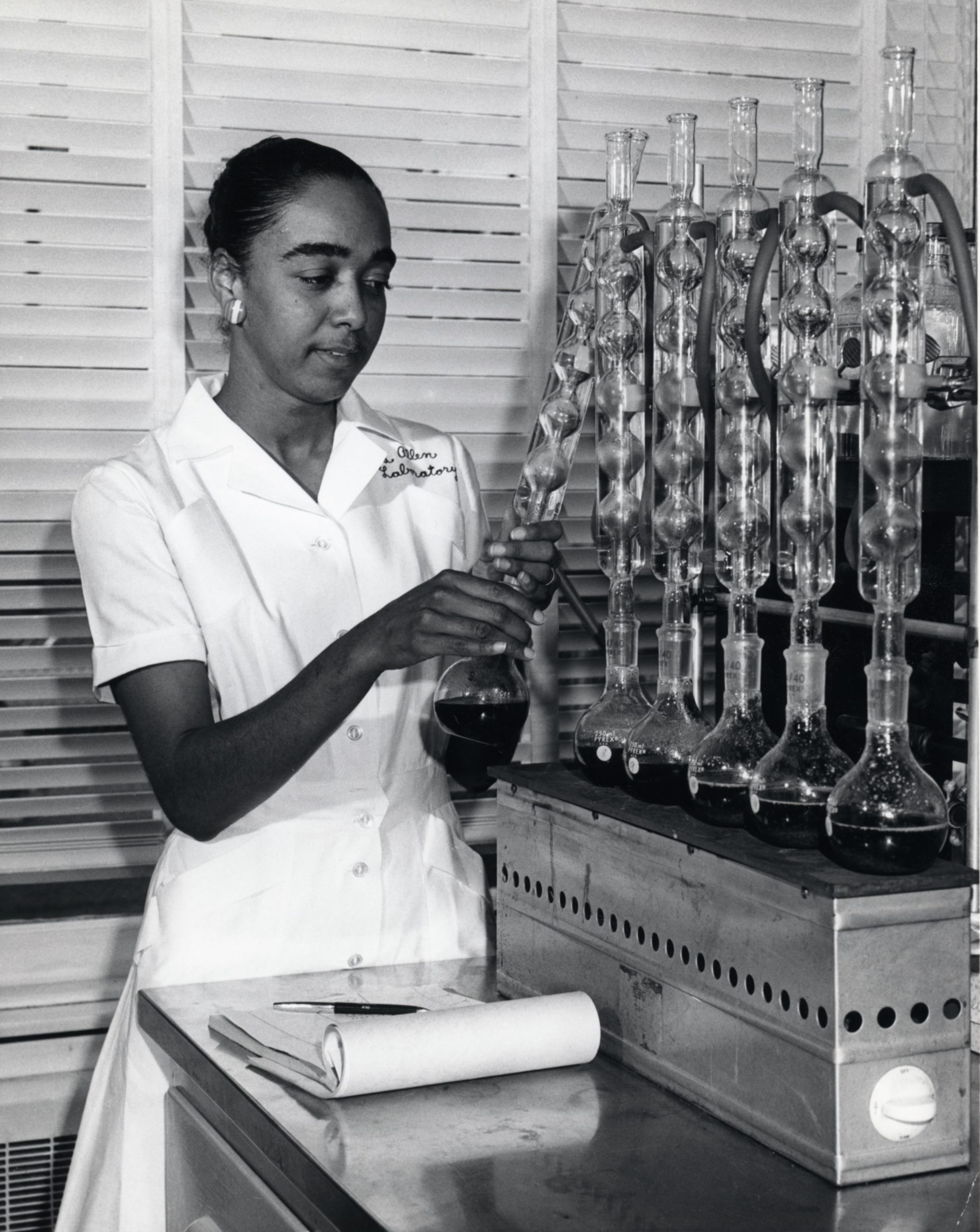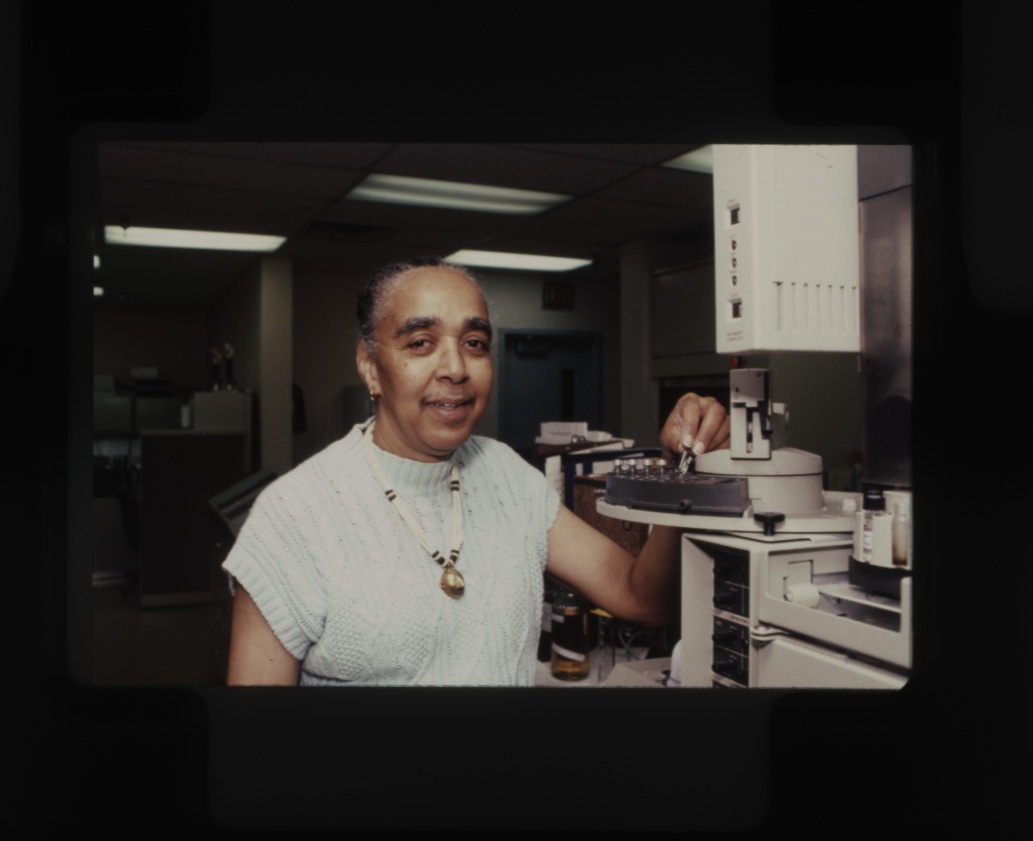
This post sponsored by Kelley Construction
Find Future Bourbon Women Events Here
Elmer Lucille Allen was recently featured on the local news in Louisville highlighting her work with Brown-Forman as a chemist, the first African-American to be hired for that position in 1966. She grew up in Louisville and graduated from Nazareth College, now Spalding, in 1953 with a degree in Chemistry. She went on to work in and help establish hospital labs and chemical company labs before landing at Brown-Forman, from which she retired in 1997. Since then she has become a noted artist in fiber and ceramics. She is also a Kentucky Colonel and co-Founder of the Bell/Miller scholarship for African American women to attend college.
BW: You have shared that you were not able to get a job as a chemist in Louisville after you graduated from college. Brown-Forman hired you in 1966, where you became the first African-American chemist at the company. What do you want younger generations to understand about that period in history and how you navigated it?
EA: The period that I grew up was segregated. I was born in 1931 to Ophelia and Elmer Johnson Hammonds Sr. I was the oldest of three children. My brother was named Elmer Johnson Hammonds Jr. and my sister was named Mary Elizabeth. Since there were 3 Elmer’s in the house, I was called “Cile,” and my brother was “Bud.” Mother worked in service as a maid/cook and my father was an L&N Pullman Porter. He also was a taxicab driver for Empire Taxi when he was furloughed periodically. Neither my father or my mother graduated from high school. I went to school with African American students who were taught by African American teachers. My sister and brother did not graduate from high school. I took courses at Central High School that prepared me to go to college. I took science and math classes plus English, Civics, Latin, French, and other required courses.
I stuttered through 12 years of school. I was the 2nd honor student but I could not say the speech that I had written. I had to go to Mrs. Kuykendall’s English class every day. I learned one sentence and then went home and talked to the mirror. I was able to deliver my commencement speech at Memorial Auditorium without any problems. I received the Louisville Defender Scholarship Medal.

There were no grants or scholarships in 1949. I paid my tuition by working at the college, St. Augustine Catholic Church, babysitting, housecleaning, etc. I attended Louisville Municipal College (LMC), the University of Louisville College for African American students, from 1949-1951, when it closed. LMC offered survey courses in English, Mathematics, Science, Social Studies, etc. LMC closed in 1951 because the Day Law was rescinded.
The DAY LAW, “An Act to Prohibit White and Colored Persons from Attending the school,” was signed into law in the Commonwealth of Kentucky by Governor J.C.W. Beckham in March 1904. The Day Law was rescinded in 1951 and the first school to accept AA students was Nazareth College.
When LMC closed in 1951 and I went to Nazareth College. I had to take 12 hours each of religion and philosophy. In addition, I took science, mathematics, psychology, English, Speech and other required courses. Nazareth graduated its first two African American students in 1951. With the help of other alumni, there is an Endowed Patricia Lauderdale Bell/Barbara Miller Scholarship for 2014.
I graduated in 1953 with a Bachelor of Science in General Education with a major in Chemistry and a minor in Mathematics.
There were two students who graduated with a degree in Chemistry in 1953. I could not find a job as a chemist. So I took a civil service exam. My first job was as a clerk-typist in Fort Benjamin Harrison, IN. I was there for a couple of months until I was hired as a med tech at Indianapolis General Hospital. I eventually went on to work for Methodist Hospital and Community Hospital. ( helped set up the labs at this hospital.)
I returned to Louisville in 1958. Worked as a med tech at Children’s Hospital, a research chemist at American Synthetic Rubber Company, and a chemist for Dr. Felix Bronner, U of L Medical and Dental Research. Another chemist’s uncle was the person in charge of the Brown-Forman R&D Department and she got me an application. I applied and was interviewed and started work there in April 1966.
My first position was as a junior chemist. I analyzed raw materials – corn, rye, and malt. Eventually I moved to other positions within the R&D Department. I retired in February 1997 as a Senior Analytical Chemist.
I developed a friendship with a person of the opposite sex and we are friends today. His wife takes us to dinner to celebrate both of our birthdays that are in August. We celebrated my 89th birthday in August at Exchange in New Albany, IN.

BW: What was the transition like from the pre-computer times as a chemist to everything becoming computerized? What was the hardest thing to learn? Were there any surprises?
EA: I took my first computer class at UL in the early 60s. This was done over the teletype. I still have some of this teletype tape. Then I wrote programs and put them on punch cards.
Brown-Forman first had Apple then IBM computers. I remember using Apple’s Visicalc which was the first spreadsheet, then I used IBM’s Lotus 1-2-3 which was a spreadsheet. I learned how to create a database using R-Base. When Microsoft Office came out it included:
Word/Excel/PowerPoint/Database. When I retired I was inputting data in Microsoft Office Database.
All test results were sent out in a spreadsheet.
The R&D lab went from a wet chemistry to computerized instruments. As new instruments were acquired lab personnel went to the individual company and learned how to use the specific instrument.

BW: As a noted artist, do you see any similarities between chemistry and art?
EA: Everything that an artist uses is based on chemistry. As a ceramic artist, the periodic table is most important because glazes are comprised of elements. Clay comes from the earth. Other chemicals can be added to clay so that it will fire at specific temperatures. I am a fiber artist and the majority of my designs are based on geometric shapes. Dyes are made from chemicals. I use natural fibers – silk and cotton. If you are a painter, you use pigments that are comprised of chemicals.
I create art because I love creating works of art for the public to view. I do not do commissions.
BW: What advice do you have for women who want to become chemists in the whiskey industry?
EA: I would advise a person to take chemistry and other STEAM classes that are offered as an undergraduate. Then continue on to get a Masters in a specified field. The individual should know the process that is used to produce bourbon. Tour different plants. Ask if you can be an intern. Ask if you can volunteer to give tours or to work during the summer. Read and document. Do not be afraid to ask questions. Read as much as you can because things are changing daily. If you want to get into the bourbon industry, take whatever job is offered to get your foot in the door. Always take notes. Always ask a second or third person to read your application. As I say, “A job of any kind is better than no job at all.”
A person entering the workforce today must know multiple software applications. You must be truthful at all times. If you do not know something, please admit that you do not know but that you are willing to learn.
BW: What is your favorite way to drink whiskey, if at all?
EA: I never did drink even though I worked in the industry for 30+ years. I recommend that you drink responsibly.

Photos Courtesy of the Brown-Forman Archives





Love this! Great read
I truly appreciate the story that you have written. This story brought back memories.
I will share this website with Brown-Forman.
Again, thanks!!!
Thank you for speaking with me! It was an honor. Cheers!
Love this. Such a great read.
This was nice to read!
This is a great article! As an African American woman from Louisville it is great to learn more about women have influenced the industry. How they have expanded and changed the roles they have had is fascinating. Thanks so much for sharing the makers with us!